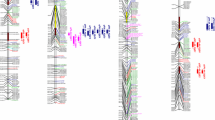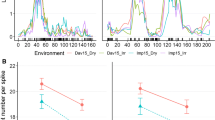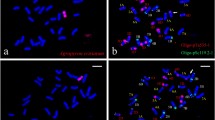Abstract
In temperate grasses, such as wheat (Triticum sp.) and barley (Hordeum vulgare L.), earliness per se (eps) is defined as the intrinsic difference in flowering time of fully vernalized plants grown under long day conditions. The main task of our investigations was to confirm and refine the chromosomal position of the previously mapped Eps-3A m locus in einkorn wheat (Shindo et al. in Genome 45:563–569, 2002; Hori et al. in Breed Sci 57:39–45, 2007). To this end, 110 recombinant inbred lines (RILs) were phenotypically and genotypically evaluated. The population had been obtained from a cross between an early flowering X-ray mutant KT3-5 (T. monococcum L.) of cultivated spring type and a wild wheat line KT1-1 of T. boeoticum Boiss. (winter type). Heading time evaluations under greenhouse conditions resulted in a 10-day difference (P = 0.008) between the mapping parents and a range of 49 days for the RIL population. Quantitative trait locus analyses of heading time, anthesis time, spikelet number and spike length showed the best linkage with marker loci close to the telomeric region of the long arm of chromosome 3A. The highest LOD values for heading time, anthesis time, spikelet number and spike length were 5.96, 5.40, 3.33 and 5.10, respectively (LOD threshold 2.0, P < 0.05). Linkage analysis of 51 molecular markers delimited the new Eps-3A m interval to 0.9 cM, including 14 newly developed markers using collinearity with rice (Oryza sativa L.) and Brachypodium distachyon L. The present study marks a further step towards the molecular elucidation and functional analysis of Eps-3A m in wheat and other small grain cereals.



Similar content being viewed by others
References
Ali ML, Baenziger PS, Al Ajlouni Z, Campbell BT, Gill KS, Eskridge KM, Mujeeb-Kazi A, Dweikat I (2011) Mapping QTL for agronomic traits on wheat chromosome 3A and a comparison of recombinant inbred chromosome line populations. Crop Sci 51:553–566
Beales J, Turner A, Griffiths S, Snape JW, Laurie DA (2007) A pseudo-response regulator is misexpressed in the photoperiod insensitive Ppd-D1a mutant of wheat (Triticum aestivum L.). Theor Appl Genet 115:721–733
Dilbirligi M, Erayman M, Campbell BT, Randhawa HS, Baenziger PS, Dweikat I, Gill KS (2006) High-density mapping and comparative analysis of agronomically important traits on wheat chromosome 3A. Genomics 88:74–87
Distelfeld A, Uauy C, Fahima T, Dubcovsky J (2006) Physical map of the wheat high-grain protein content gene Gpc-B1 and development of a high-throughput molecular marker. New Phytol 169:753–763
Doyle JJ, Doyle JL (1990) Isolation of plant DNA from fresh tissue. Focus 12:13–15
Faricelli ME, Valarik M, Dubcovsky J (2010) Control of flowering time and spike development in cereals: the earliness per se Eps-1 region in wheat, rice, and Brachypodium. Funct Integr Genomics 10:293–306
Farré A, Lacasa Benito I, Cistué L, de Jong J, Romagosa I, Jansen J (2010) Linkage map construction involving a reciprocal translocation. Theor Appl Genet 122:1029–1037
Feldman M (ed) (2001) Origin of cultivated wheat. Lavoisier Publishing, Paris
Flood RG, Halloran GM (1984) Temperature as a component of the expression of developmental responses in wheat. Euphytica 33:91–98
Griffiths S, Simmonds J, Leverington M, Wang Y, Fish L, Sayers L, Alibert L, Orford S, Wingen L, Herry L, Faure S, Laurie D, Bilham L, Snape J (2009) Meta-QTL analysis of the genetic control of ear emergence in elite European winter wheat germplasm. Theor Appl Genet 119:383–395
Hall TA (1999) Bioedit: a user-friendly biological sequence alignment editor and analysis program for windows 95/98/nt. Nucleic Acid Symp Ser 41:95–98
Hanocq E, Laperche A, Jaminon O, Lainé A, Le Gouis J (2007) Most significant genome regions involved in the control of earliness traits in bread wheat, as revealed by QTL meta-analysis. Theor Appl Genet 114:569–584
Hedrick PW, Muona O (1990) Linkage of viability genes to marker loci in selfing organisms. Heredity 64:67–72
Hoogendoorn J (1985) A reciprocal F1 monosomic analysis of the genetic-control of time of ear emergence, number of leaves and number of spikelets in wheat (Triticum aestivum L.). Euphytica 34:545–558
Hori K, Takehara S, Nankaku N, Sato K, Sasakuma T, Takeda K (2007) Barley EST markers enhance map saturation and QTL mapping in diploid wheat. Breed Sci 57:39–45
International Brachypodium Initiative (2009) Genome sequencing and analysis of the model grass Brachypodium distachyon. Nature 463:763–768
International Rice Genome Sequencing Project (2005) The map-based sequence of the rice genome. Nature 436:793–800
Jansen RC (2003) Quantitative trait loci in inbred lines. In: Balding DJ, Bishop M, Cannings C (eds) Handbook of statistical genetics. Wiley, Chichester, pp 445–476
Kasha KJ, Kao KN (1970) High frequency haploid production in barley (Hordeum vulgare L.). Nature 225:874–876
Kato K, Yamagata H (1988) Method for evaluation of chilling requirement and narrow-sense earliness of wheat cultivars. Jpn J Breed 38:172–186
Laurie DA, Pratchett N, Bezant JH, Snape JW (1995) RFLP mapping of 5 major genes and 8 quantitative trait loci controlling flowering time in a winter x spring barley (Hordeum vulgare L.) cross. Genome 38:575–585
Law CN, Worland AJ (1997) Genetic analysis of some flowering time and adaptive traits in wheat. New Phytol 137:19–28
Law CN, Worland AJ, Giorgi B (1976) Genetic-control of ear-emergence time by chromosomes-5A and chromosomes-5D of wheat. Heredity 36:49–58
Le Gouis J, Bordes J, Ravel C, Heumez E, Faure S, Praud S, Galic N, Remoué C, Balfourier F, Allard V, Rousset M (2011) Genome-wide association analysis to identify chromosomal regions determining components of earliness in wheat. Theor Appl Genet 1–15. doi:10.1007/s00122-011-1732-3
Lewis S, Faricelli ME, Appendino ML, Valarik M, Dubcovsky J (2008) The chromosome region including the earliness per se locus Eps-A(m)1 affects the duration of early developmental phases and spikelet number in diploid wheat. J Exp Bot 59:3595–3607
Lorieux M, Goffinet B, Perrier X, Deleon DG, Lanaud C (1995) Maximum-likelihood models for mapping genetic-markers showing segregation distortion.1. Backcross populations. Theor Appl Genet 90:73–80
Luo L, Xu S (2003) Mapping viability loci using molecular markers. Heredity 90:459–467
Marais GF (1992) Genetic control of a response to the segregation distortion allele, Sd-1d, in the common wheat line ‘Indis’. Euphytica 60:89–95
Marquez-Cedillo LA, Hayes PM, Kleinhofs A, Legge WG, Rossnagel BG, Sato K, Ullrich SE, Wesenberg DM (2001) QTL analysis of agronomic traits in barley based on the doubled haploid progeny of two elite North American varieties representing different germplasm groups. Theor Appl Genet 103:625–637
Mayer KFX, Martis M, Hedley PE, Simkova H, Liu H, Morris JA, Steuernagel B, Taudien S, Roessner S, Gundlach H, Kubalakova M, Suchankova P, Murat F, Felder M, Nussbaumer T, Graner A, Salse J, Endo T, Sakai H, Tanaka T, Itoh T, Sato K, Platzer M, Matsumoto T, Scholz U, Dolezel J, Waugh R, Stein N (2011) Unlocking the barley genome by chromosomal and comparative genomics. Plant Cell 23:1249–1263
Millet E (1987) Monosomic analysis of heading date and spikelet number in the common wheat (Triticum aestivum L.) multi-spikelet line Noa. Theor Appl Genet 74:487–492
Miura H, Worland AJ (1994) Genetic control of vernalization, day-length response, and earliness per se by homoeologous group-3 chromosomes in wheat. Plant Breed 113:160–169
Miura H, Nakagawa M, Worland AJ (1999) Control of ear emergence time by chromosome 3A of wheat. Plant Breed 118:85–87
Neff MM, Turk E, Kalishman M (2002) Web-based primer design for single nucleotide polymorphism analysis. Trends Genet 18:613–615
Ooijen V (2004) MapQTL® 5, Software for the mapping of quantitative trait loci in experimental populations. Kyazma B.V., Wageningen
Ooijen V (2006) JoinMap® 4, Software for the calculation of genetic linkage maps in experimental populations. Kyazma B.V., Wageningen
Paillard S, Schnurbusch T, Winzeler M, Messmer M, Sourdille P, Abderhalden O, Keller B, Schachermayr G (2003) An integrative genetic linkage map of winter wheat (Triticum aestivum L.). Theor Appl Genet 107:1235–1242
Quillet MC, Madjidian N, Griveau Y, Serieys H, Tersac M, Lorieux M, Berville A (1995) Mapping genetic factors controlling pollen viability in an interspecific cross in Helianthus sect Helianthus. Theor Appl Genet 91:1195–1202
Rozen S, Skaletsky HJ (2000) Primer3 on the WWW for general users and for biologist programmers. In: Krawetz S, Misener S (eds) Bioinformatics methods and protocols: methods in molecular biology. Humana Press, Totowa, pp 365–386
Sato K, Nankaku N, Takeda K (2009) A high-density transcript linkage map of barley derived from a single population. Heredity 103:110–117
Scarth R, Law CN (1983) The location of the photoperiod gene, Ppd2 and an additional genetic factor for ear emergence time on chromosome 2B of wheat. Heredity 51:607–619
Schnurbusch T, Collins NC, Eastwood RF, Sutton T, Jefferies SP, Langridge P (2007) Fine mapping and targeted SNP survey using rice-wheat gene collinearity in the region of the Bo1 boron toxicity tolerance locus of bread wheat. Theor Appl Genet 115:451–461
Semagn K, Bjornstad A, Skinnes H, Maroy AG, Tarkegne Y, William M (2006) Distribution of DArT, AFLP, and SSR markers in a genetic linkage map of a doubled-haploid hexaploid wheat population. Genome 49:545–555
Shindo C, Sasakuma T (2001) Early heading mutants of T. monococcum and Ae. squarrosa, A- and D-genome ancestral species of hexaploid wheat. Breed Sci 51:95–98
Shindo C, Sasakuma T, Watanabe N, Noda K (2002) Two-gene systems of vernalization requirement and narrow-sense earliness in einkorn wheat. Genome 45:563–569
Singh K, Ghai M, Garg M, Chhuneja P, Kaur P, Schnurbusch T, Keller B, Dhaliwal HS (2007) An integrated molecular linkage map of diploid wheat based on a Triticum boeoticum x T. monococcum RIL population. Theor Appl Genet 115:301–312
Slafer GA (1996) Differences in phasic development rate amongst wheat cultivars independent of responses to photoperiod and vernalization. A viewpoint of the intrinsic earliness hypothesis. J Agric Sci 126:403–419
Snape JW, Sarma R, Quarrie SA, Fish L, Galiba G, Sutka J (2001) Mapping genes for flowering time and frost tolerance in cereals using precise genetic stocks. Euphytica 120:309–315
Tranquilli G, Dubcovsky J (2000) Epistatic interaction between vernalization genes Vrn-A m 1 and Vrn-A m 2 in diploid wheat. J Hered 91:304–306
Turner A, Beales J, Faure S, Dunford RP, Laurie DA (2005) The pseudo-response regulator Ppd-H1 provides adaptation to photoperiod in barley. Science 310:1031–1034
Vincze T, Posfai J, Roberts RJ (2003) NEBcutter: a program to cleave DNA with restriction enzymes. Nucleic Acids Res 31:3688–3691
Welsh JR, Keim DL, Pirasteh B, Richards RD (1973) Genetic control of photoperiod response in wheat. In: Sears ER, Sears LMS (eds) Proceedings of the 4th international wheat genetics symposium. University of Missouri Press, Columbia, Missouri, pp 879–884
Worland AJ, Law CN (1986) Genetic analysis of chromosome 2D of wheat. The location of genes affecting height, day-length insensitivity, hybrid dwarfism and yellow-rust resistance. Z Pflanzenzucht 96:331–345
Xue SL, Zhang ZZ, Lin F, Kong ZX, Cao Y, Li CJ, Yi HY, Mei MF, Zhu HL, Wu J, Xu HB, Zhao DM, Tian DG, Zhang CQ, Ma Z (2008) A high-density intervarietal map of the wheat genome enriched with markers derived from expressed sequence tags. Theor Appl Genet 117:181–189
Yan L, Loukoianov A, Tranquilli G, Helguera M, Fahima T, Dubcovsky J (2003) Positional cloning of the wheat vernalization gene Vrn1. Proc Natl Acad Sci USA 100:6263–6268
Yan LL, Loukoianov A, Blechl A, Tranquilli G, Ramakrishna W, SanMiguel P, Bennetzen JL, Echenique V, Dubcovsky J (2004) The wheat Vrn2 gene is a flowering repressor down-regulated by vernalization. Science 303:1640–1644
Yan L, Fu D, Li C, Blechl A, Tranquilli G, Bonafede M, Sanchez A, Valarik M, Yasuda S, Dubcovsky J (2006) The wheat and barley vernalization gene Vrn3 is an orthologue of FT. Proc Natl Acad Sci USA 103:19581–19586
Zhang L, Wang S, Li H, Deng Q, Zheng A, Li S, Li P, Li Z, Wang J (2010) Effects of missing marker and segregation distortion on QTL mapping in F2 populations. Theor Appl Genet 121:1071–1082
Acknowledgments
The authors would like to express their gratitude to Dr. Tomohiro Ban from Yokohama City University for donating the seed samples and to the IPK gardeners supervised by Mrs. Kathrin Gramel-Eikenroth for looking after the plants. We also appreciate the Sanger sequencing service provided by Mrs. Susanne König. The work has been supported by a grant from the Deutsche Forschungsgemeinschaft (DFG, FKZ SCHN 768-3-1-569091) to TS.
Author information
Authors and Affiliations
Corresponding author
Electronic supplementary material
Below is the link to the electronic supplementary material.
Rights and permissions
About this article
Cite this article
Gawroński, P., Schnurbusch, T. High-density mapping of the earliness per se-3Am (Eps-3A m) locus in diploid einkorn wheat and its relation to the syntenic regions in rice and Brachypodium distachyon L.. Mol Breeding 30, 1097–1108 (2012). https://doi.org/10.1007/s11032-011-9697-0
Received:
Accepted:
Published:
Issue Date:
DOI: https://doi.org/10.1007/s11032-011-9697-0




